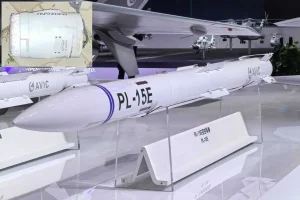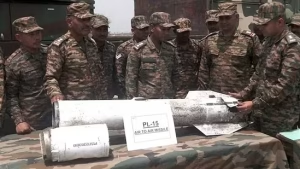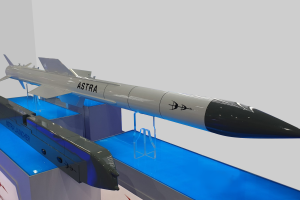New Delhi – The Defence Research and Development Organisation has made a strategic decision to incorporate advanced technological features from the Chinese PL-15 air-to-air missile into India’s indigenous Astra Mark-2 programme. This breakthrough development follows a comprehensive DRDO PL-15 missile technical analysis conducted on an unexploded weapon recovered during Operation Sindoor in May, offering Indian defence scientists an unprecedented intelligence opportunity.
Rare Recovery During Operation Sindoor

The DRDO PL-15 missile analysis became possible when the weapon was recovered fully intact in a field near Hoshiarpur, Punjab, on May 9. This recovery represented an exceptional intelligence windfall, as the export variant of China’s advanced beyond-visual-range missile fell into Indian hands in pristine condition.
The DRDO PL-15 missile, specifically the PL-15E export variant with a range of 145 kilometres, remained unexploded due to a critical design characteristic—the weapon lacks a self-destruct mechanism. This stands in stark contrast to all Indian air-to-air missiles, which incorporate self-destruct features as standard safety protocols.
Context of the Recovery

The DRDO PL-15 missile recovery occurred during Operation Sindoor, India’s coordinated military response launched on May 7 to the April 22 Pahalgam terror attack that killed 26 civilians. The missile, believed to have been fired from a Pakistan Air Force JF-17 or J-10C fighter aircraft, failed to engage its target and fell approximately 100 kilometres inside Indian territory.
This operational failure by Pakistani forces inadvertently provided Indian defence scientists with access to one of China’s most advanced air-to-air weapons, enabling detailed examination of cutting-edge military technology that would otherwise remain beyond reach.
Advanced Features Identified
While DRDO remains officially tight-lipped about the complete analysis report submitted to the defence ministry, the DRDO PL-15 missile examination has identified several superior technological features. These discoveries represent significant advancements in air-to-air missile technology that India is now positioning to incorporate into its own programmes.
The DRDO PL-15 missile analysis revealed a miniature active electronically scanned array (AESA) radar system, representing a major technological achievement in compact radar design. Additionally, the weapon features advanced propellant formulations capable of maintaining speeds exceeding Mach 5, providing extended range and reduced interception opportunities.
Sophisticated Anti-Jamming Capabilities


Among the most significant findings in the DRDO PL-15 missile study were sophisticated anti-jamming capabilities that enhance the weapon’s effectiveness in contested electromagnetic environments. Modern aerial combat increasingly involves electronic warfare, making resistance to jamming crucial for missile reliability and success rates.
These anti-jamming features identified in the DRDO PL-15 missile analysis are now being prioritized for incorporation into India’s indigenous Astra missile development programme. The radar technology, in particular, represents a significant advancement that will enhance the Astra Mark-2’s operational effectiveness.
Pakistan’s Arsenal Enhancement Efforts
Intelligence sources indicate that Pakistan is actively seeking to enhance its arsenal following Operation Sindoor. The Pakistan Air Force is reportedly pursuing longer-range PL-17 missiles for wide-bodied aircraft from China, demonstrating continued reliance on Chinese military technology.
Additionally, Pakistan has expressed interest in acquiring 2,000 YIHA kamikaze drones from Turkey and has submitted an extensive list of high-tech weapons requirements to the United States. These procurement efforts reflect Pakistan’s recognition of capability gaps exposed during recent operations involving the DRDO PL-15 missile and other advanced weapons systems.
Also Read: Trump China Tariffs: Shocking Admission They’re ‘Not Sustainable’
Indian Weapons Performance
Despite the valuable insights gained from the DRDO PL-15 missile analysis, Indian defence officials noted that indigenous weapons performed effectively during Operation Sindoor. BrahMos, Rampage, and SCALP missiles demonstrated excellent operational results, validating India’s growing domestic defence manufacturing capabilities.
However, the DRDO PL-15 missile study has prompted Indian defence planners to pursue additional Meteor missiles for Rafale fighters, ensuring the Indian Air Force is not constrained by ammunition numbers in future engagements. A next-generation BrahMos missile with an 800-kilometre range is also under development, providing coverage across nearly the entire breadth of Pakistan.
Evolving Strategic Landscape
The DRDO PL-15 missile analysis occurs within a rapidly evolving threat landscape. Pakistan’s acquisition of three to five Chinese HQ-9 air defence systems has prompted strategic adjustments in Indian operational planning. Future hostilities will likely see Indian fighters operating from outside enemy air defence envelopes, launching long-range supersonic missiles designed to defeat ground and airborne radar systems.
This shift reflects lessons learned not only from the DRDO PL-15 missile recovery but from the broader operational experience of Operation Sindoor, where integrated air defence systems posed significant challenges.
Ceasefire Violations and Future Posture
Indian national security planners have documented concerning ceasefire violations that occurred even after the DRDO PL-15 missile was recovered. Pakistan fired kamikaze armed drones and rockets in the Jammu and Rajasthan sectors after the ceasefire was declared and communicated to all formations at 5 pm on May 10.
Pakistani forces demonstrated similar behavior recently when they launched air strikes against civilian populations in Spin Boldak, a border city in Afghanistan, despite agreeing to a 48-hour no-fire pact with the Taliban.
Strategic Implications
While Indian armed forces did not retaliate to Pakistan’s ceasefire violations on May 10, officials indicated that New Delhi would adopt a less forgiving approach in future incidents. The DRDO PL-15 missile analysis has provided India with valuable intelligence about adversary capabilities, but it has also reinforced the need for continued indigenous development and strategic preparedness.
Astra Mark-2 Enhancement
The incorporation of technologies identified through the DRDO PL-15 missile analysis into the Astra Mark-2 programme represents a significant advancement for Indian air-to-air missile capabilities. By adopting the miniature AESA radar technology, advanced propellant systems, and sophisticated anti-jamming features, India is positioning its indigenous missile programme to compete with the world’s most advanced weapons systems.
This strategic decision to leverage insights from the DRDO PL-15 missile exemplifies how unexpected intelligence opportunities can accelerate domestic defence technology development, ultimately strengthening national security capabilities.

